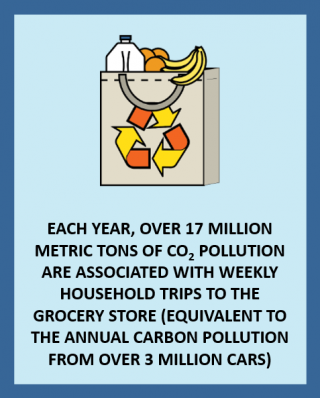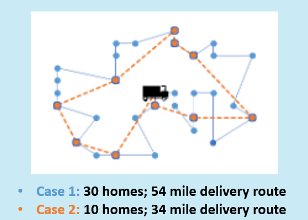What If More People Bought Groceries Online Instead of Driving to a Store?

Driving to the grocery store each week can be a hassle. For those who have health or mobility issues that make it difficult to shop, and for the growing number of U.S. households that don’t own a car, getting groceries can be a challenge. How convenient it may be to, instead, have groceries delivered straight to your doorstep. About 15% of Americans have tried online grocery shopping at least once.1 This number is likely to increase as delivery services from traditional grocery stores, food co-ops, and online retailers become available in more cities and regions across the country. What impact will this have on the environment? Delivery trucks typically get fewer miles to the gallon than cars, but each household making individual trips to the store isn’t efficient or pollution-free either. What if more people bought their groceries online?
What's the big deal?

A recent USDA survey found that in 88% of U.S households, people hop in their car to buy groceries, driving an average of 4 miles to their preferred store.2 If each of these households took at least one trip per week, that would add up to over 42 billion miles driven round-trip each year—about 10 times the distance to Pluto!3 All these car trips result in carbon pollution: over 17 million metric tons of CO2 come from car tailpipes just from driving back and forth to the grocery store. That number may even be higher, since many families take more than one trip per week. (“Oh no! We’re out of milk again.”)
What would it be like?
By letting your food share a ride with other orders, grocery delivery has the potential to reduce the number of vehicles on the road. However, how much this would lower pollution—if at all—depends on many factors. Consider the following examples.4

Case 1: You and 29 other households in your neighborhood request delivery from the local grocery store on the same day. You each give the company flexibility to deliver at a time that allows them to make all deliveries in one trip. In addition, the company uses a relatively fuel efficient delivery truck that gets 14 mpg. In this case, ordering online could cut greenhouse gases (GHGs) in half compared to each household driving to the store.5
Case 2: You and your neighbors request deliveries in narrow time windows that you find more convenient. Now the company can only deliver 9 other orders along with yours. The delivery truck has a fuel economy of only 10 mpg. In this case, ordering online causes more GHG emissions than would driving to the store.
- Tomorrow’s trucks will be more efficient. Standards set by EPA and DOT require trucks to reduce GHG emissions and improve fuel economy each year through 2018 and additional standards have been proposed through 2027.
- Alternative fuels hold promise. Using hydrogen fuel to refrigerate the trucks and keep cargo cool, or using hydrogen or electricity to power delivery trucks, could reduce GHGs.
- Your choices matter. Try to be flexible so delivery trucks can optimize their routes and avoid extra trips. Some grocery stores provide discounts for choosing longer delivery windows.
- Place as much as you can in each order to avoid frequent delivery trips. You may even consider “grocery-pooling” with neighbors by requesting delivery at the same time.
- If available, consider a grocery service that delivers by bike or foot! Of course, if you are able to walk, bike, or take public transit to do your shopping, that will always be a low pollution option.
Next time you’re deciding whether to grab the car keys or your mouse, just consider the above as some food for thought.
What If More People Bought Groceries Online Instead of Driving to a Store? (PDF) (2 pp, 278 K, EPA-420-F-16-001, January 2016 About PDF)
- Hartman Strategies, The Future of E-Commerce in Modern Food Culture, HartbeatExec, 4, no. 2 (2014).
- Ver Ploeg, Michele, Lisa Mancino, Jessica E. Todd, Dawn Marie Clay, and Benjamin Scharadin. Where Do Americans Usually Shop for Food and How Do They Travel To Get There? Initial Findings From the National Household Food Acquisition and Purchase Survey, EIB-138, U.S. Department of Agriculture, Economic Research Service, March 2015, available at: https://www.ers.usda.gov/publications/pub-details/?pubid=79791
- We assumed 115,610,216 households based on data from the U.S. Census Bureau’s QuickFacts accessed in 2015. You can find the current QuickFacts at: https://www.census.gov/quickfacts/fact/table/US/PST045221. Note that because the data is periodically updated, the number of U.S. households may differ from what is listed here.
- We compare emissions from delivery service to an individual who drives eight miles round-trip to the grocery store in a 22 mpg car. Any GHG benefits from delivery would be reduced for individuals driving higher mpg cars. The diagram and two case study routes are examples for illustrative purposes only. The total miles driven for delivery routes will vary based on geographic density and other factors. For simplicity, we assumed the deliveries originate from the same store that customers use. In practice, grocers may ship from local depots or regional warehouses causing different emissions impacts.
- Even when grocery delivery reduces GHGs, other harmful pollutants like NOx and particulate matter could increase.
